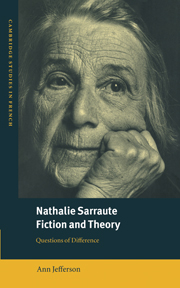Book contents
- Frontmatter
- Contents
- Acknowledgements
- List of abbreviations
- Introduction
- Part I DIFFERENCE AND HUMAN RELATIONS
- Chapter One Difference and dissension
- Chapter Two Subjectivity and indistinction
- Chapter Three Abjection into art
- Part II THE BODY AND SEXUAL DIFFERENCE
- Part III GENRE AND DIFFERENCE
- Part IV CONCLUSION
- Notes
- Bibliography
- Index
- CAMBRIDGE STUDIES IN FRENCH
Chapter One - Difference and dissension
Published online by Cambridge University Press: 22 September 2009
- Frontmatter
- Contents
- Acknowledgements
- List of abbreviations
- Introduction
- Part I DIFFERENCE AND HUMAN RELATIONS
- Chapter One Difference and dissension
- Chapter Two Subjectivity and indistinction
- Chapter Three Abjection into art
- Part II THE BODY AND SEXUAL DIFFERENCE
- Part III GENRE AND DIFFERENCE
- Part IV CONCLUSION
- Notes
- Bibliography
- Index
- CAMBRIDGE STUDIES IN FRENCH
Summary
Il n'y pas de moyen terme entre l'admission et l'exclusion.
[There is no middle way between admittance and exclusion.]
(Entre la vie et la mort, p. 149 [156])‘Différences’ and ‘Différends’
Reading Sarraute is often a deeply disorientating experience. Characteristically, the opening page of a Sarraute novel pitches one into a situation in which nothing is immediately explained, and where the unnamed and unidentified participants exacerbate the reader's sense of disorientation by expressing themselves in the form of questions:
Soudain il s'interrompt, il lève la main, l'index dressé, il tend l'oreille … Vous les entendez? … (VLE)
[Suddenly he pauses, raises his hand, his forefinger in the air, he strains to catch the sound … Do you hear them?]
Elle est mignonne, n'est-ce pas? Regardez-moi ça … regardez-comme c'est fin … (DLI)
[She's sweet, isn't she? Just look at that … see how fine it is …]
– «Vous ne vous aimez pas.» Mais comment ça? Comment est-ce possible? Vous ne vous aimez pas? Qui n'aime pas qui? (TNTP)
[‘You don't love yourself.’ But what does that mean? How is that possible? You don't love yourself? Who doesn't love whom?]
Who is “il”? Whom or what can he hear? Does “elle” refer to a person or an object? And, as the last question puts it, who does not love whom? Furthermore, in each case we are not told to whom the question is addressed and what their role in the situation is.
- Type
- Chapter
- Information
- Nathalie Sarraute, Fiction and TheoryQuestions of Difference, pp. 17 - 38Publisher: Cambridge University PressPrint publication year: 2000



